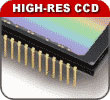Difference between revisions of "Image Sensor"
| Line 1: | Line 1: | ||
| − | Every digital camera requires an image sensor to function and | + | Every digital camera requires an image sensor to function and there are two options: '''CCD''' (charge-coupled device) and '''CMOS''' (complementary metal oxide semiconductor). Our camera uses a CCD, the '''professional grade image sensor'''. |
[[Image:CCD.jpg|left]] | [[Image:CCD.jpg|left]] | ||
| − | + | Both types of sensor have the same objective: to turn light into electrons to capture the image. However, there are some very noticeable differences between the two. CCD technology has been used in professional quality cameras for over 20 years. It creates a more high-quality, low-noise image than CMOS. It also nearly doubles the Dynamic Range, meaning the range of dark to light values that can successfully be recorded is much higher than that of the CMOS. | |
| − | + | With a CCD, you get the up-to-date, crystal-clear image quality you would expect from a high quality digital camera. With a more quickly and inexpensively produced CMOS, you get grainier, lower-pixel images. | |
Revision as of 19:20, 20 September 2006
Every digital camera requires an image sensor to function and there are two options: CCD (charge-coupled device) and CMOS (complementary metal oxide semiconductor). Our camera uses a CCD, the professional grade image sensor.
Both types of sensor have the same objective: to turn light into electrons to capture the image. However, there are some very noticeable differences between the two. CCD technology has been used in professional quality cameras for over 20 years. It creates a more high-quality, low-noise image than CMOS. It also nearly doubles the Dynamic Range, meaning the range of dark to light values that can successfully be recorded is much higher than that of the CMOS.
With a CCD, you get the up-to-date, crystal-clear image quality you would expect from a high quality digital camera. With a more quickly and inexpensively produced CMOS, you get grainier, lower-pixel images.
